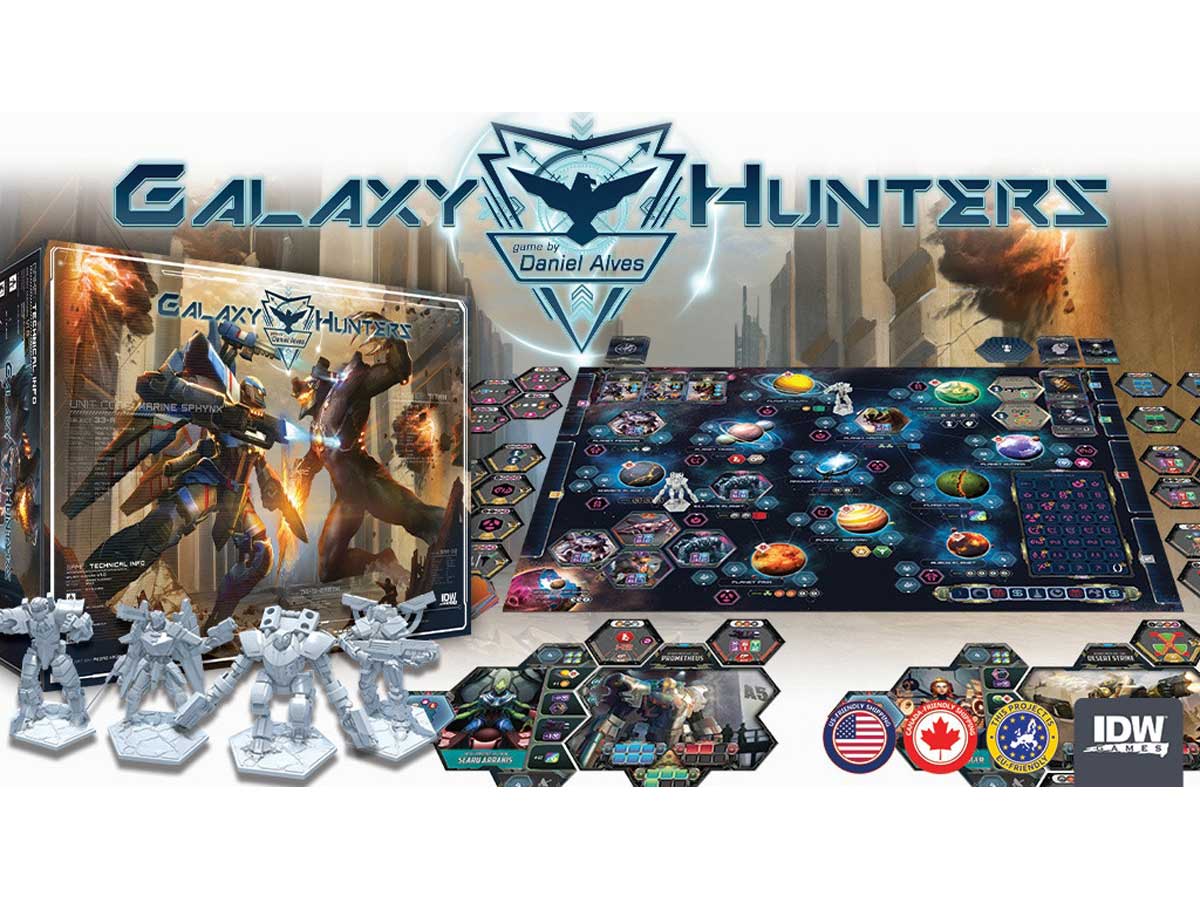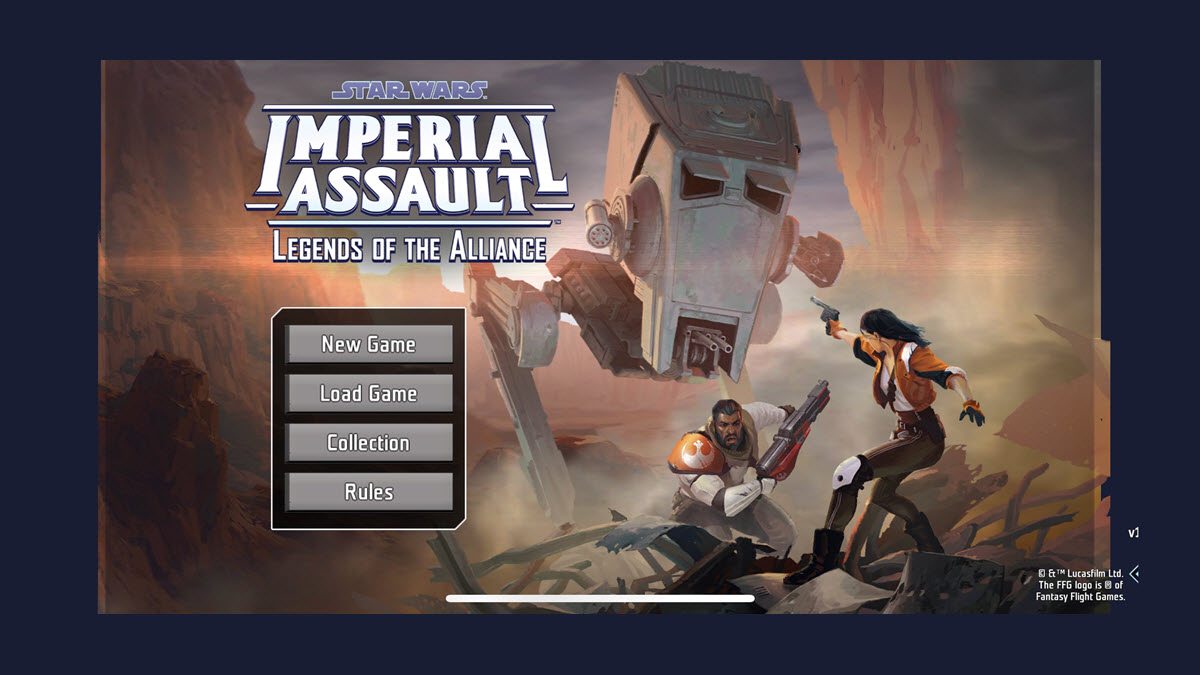Galaxy Hunters has just added an expansion, New Ways to Hunt, to their mech piloting, mutant hunting, space-based worker placement game that is currently on Kickstarter. While this review does touch on the base game, our focus is mainly on the new expansion.
What Is Galaxy Hunters?
Galaxy Hunters is a worker placement game for 2-4 players (5 with the expansion), ages 14 and up, and takes about 30 minutes to play per player. It’s currently seeking funding on Kickstarter, with a pledge level of $79 for a copy of the base game, or $99 for the game and expansion. As an added bonus, all pledges now also include all of the unlocked stretch goals!
Galaxy Hunters was designed by Daniel Alves and published by IDW Games.
New to Kickstarter? Check out our crowdfunding primer.
Galaxy Hunters Components
Note: My review is based on a prototype copy of the game, so it is subject to change and may not reflect final component quality or details.

Base Game Components
- 1 Game board
- 4 65mm Mech Miniatures (4 more KS Exclusives have been added via stretch goals)
- 4 Pilot Tiles (4 more KS Exclusives have been added via stretch goals)
- 4 Mech Tiles (4 more KS Exclusives have been added via stretch goals)
- 4 Reputation track markers
- 1 Turn marker
- 1 Invasion marker
- 4 Resource tracker boards
- 4 Sets of 10 resource tracking tokens
- 4 Sets of 3 wooden agent ships
- 13 Pilot upgrade tiles
- 30 Mutant tiles (7 more KS Exclusives have been added via stretch goals)
- 45 Mech Upgrade tiles (8 more KS Exclusives have been added via stretch goals)
- 45 Mission Cards (15 more KS Exclusives have been added via stretch goals)
- 24 Specialist Cards
- 100 DNA tokens (30 more KS Exclusives have been added via stretch goals)
- 90 Energy, Armor, and Ammo stat cubes
Expansion Components
- 1 65mm Mech Miniature
- 1 Pilot Tile
- 1 Mech Tile
- 5 Mech Combat Panels
- 1 Reputation track marker
- 1 Resource Tracker board
- 1 Set of 10 resource tracking tokens
- 1 Set of 3 wooden agent ships
- 4 Battery Tiles
- 10 Ambassador Tiles
- 50 Armor and battery stat cubes
- 10 combat dice
While I was sent a prototype of the base and expansion to review, most of the game has the look and feel of a completed, polished version, so I don’t expect the quality of the finished game to be too different from what I saw. The only exception is that the mech miniatures I received are clearly initial 3D printed versions, but the quality and design of them is awesome to behold!
How to Play Galaxy Hunters – Base Game
The Goal
The goal of the game is be the player with the most Victory Points once the game ends and everything is tallied up. From a story perspective, you are a mercenary hired by the Mega Corps (who now control the universe) to hunt down mutants and extract their DNA for the (most likely nefarious) plans of the Mega Corps.
Setup – Base Game
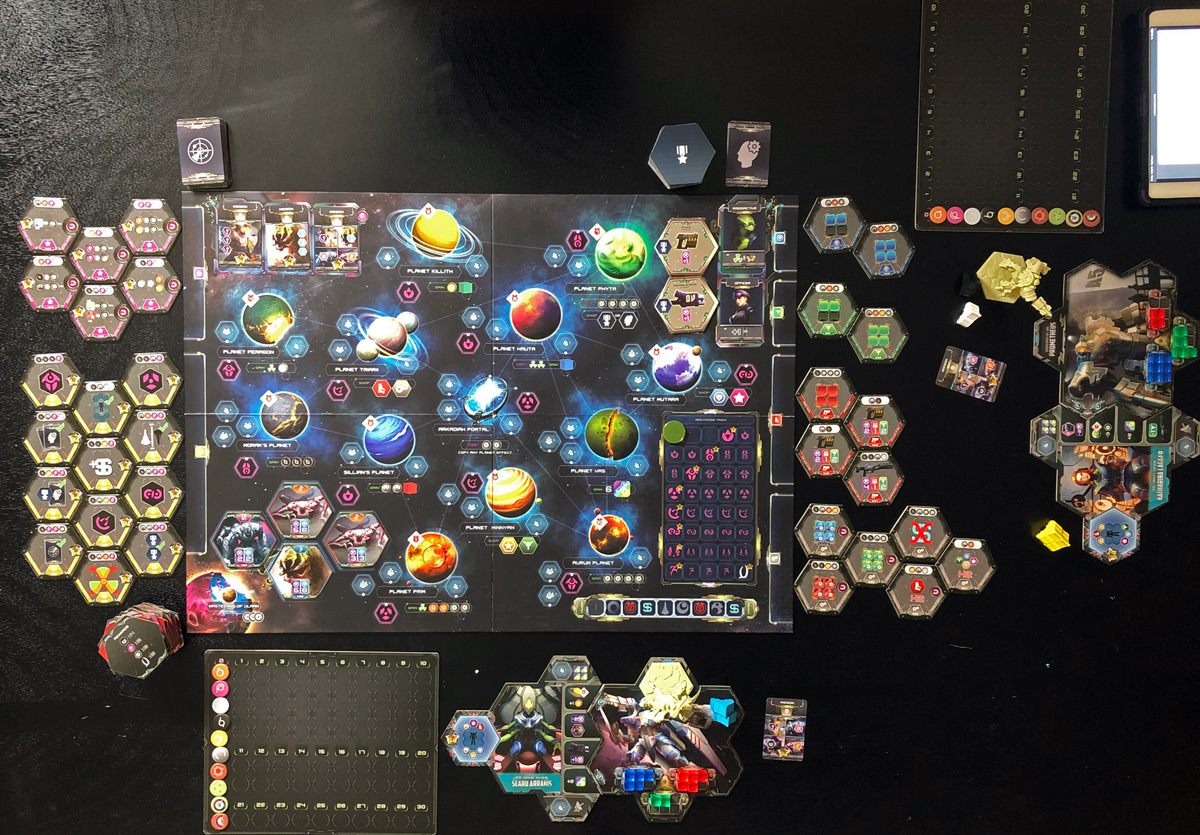
As pictured, there are a lot of components to setup and get into place, but once you learn what everything is, setup is pretty straightforward. One thing to note though is that this game does need a lot of table real-estate. Many of the components are variable by player count, so any component that has a 3+ on it should only be used when there are more than 2 players. Otherwise all setup below remains the same regardless of player count.
The game board is laid out, the invasion marker is placed on Planet 1, the turn marker is placed on the turn tracker. Then all of the tiles and upgrades are put into place. The mutant tiles are shuffled and the top 4 flipped onto planet Ulaan with the remaining stack face down beside the planet.
The upgrade tiles are all placed face up so that they are all visible and beside their corresponding section around the board (as indicated by the icons on the right and left side) with the exception of the pilot upgrades.
The pilot upgrade tiles are shuffled and placed face down, with the top two being flipped over and placed on the board in their spaces in the upper right corner. The specialist cards get the same treatment. The mission cards are also shuffled, one is dealt to each player, then the top three are flipped and placed in their spaces in the upper left corner.
Once the game board is setup, its time to set up the players. Each player chooses a color and gets the wooden ships and track markers of that color. Only two of the wooden ships are used at the start of the game so the third can be set aside until turn 4. The reputation trackers for all players go onto the board on the first space.
Each player gets a resource tracking board and a set of resource tracking tokens, all of which should be placed on the “0” column. Player order for the first round should be decided randomly or by consensus and then players receive starting credits based on their turn order (1 for first, 2 for second, etc).

The first player receives all of the mech tiles, while the last player receives all of the pilot tiles. The first player selects a mech and passes them down, then the last player selects a pilot and passes them up. This continues back and forth until all players have a mech tile and a pilot tile. The tiles are placed in front of the player (pilot on the left, mech on the right with the hex edges nestled against each other) and appropriate armor, ammo, and energy cubes are handed out and placed on the mech tiles.
Lastly, each player gets their mech miniature that corresponds with their mech tile. Scroll down to the Expansion section for the changes it introduces.
Gameplay – Base Game
This is a quick overview of the play in the base game. We’ll take a deeper dive on some of the rules down in the Expansion section as we cover how they change or are modified by the expansion itself.
The main gameplay, while there are some details we’re bypassing for the sake of brevity, is actually very straightforward and easy to learn and remember after just a couple of turns. Each turn of the game is divided into two phases – the Action Phase and the Maintenance Phase. There are nine turns to the game.
Action Phase
During the action phase, each player gets a number of actions equal to the amount of ships and mechs they have. Each player gets to take one action, play passes to the next player to take one action and so on until all players have taken all of their actions.
Players have two choices for actions – docking a ship or deploying their mech.

A ship can be docked on a planet or on the docking spaces on the player’s tiles. An eligible docking area is one that matches the number of players in the game or has a Reputation icon matching the players current reputation. Some spaces indicate they are only available in 3+ or 4+ player games. If there is a mutant on a planet it costs two ships to dock on a planet (effectively reducing the number of actions that player would get otherwise.) The Effect listed on the planet or tile docking space is immediately triggered.

We won’t dive into the details in this review but each planet essentially has two types of effects – gaining free resources, or shopping for specific upgrades. The player can pay the cost and purchase one upgrade of the type indicated on the planet and add it to their mech, player, or play area.
A mech can be deployed to any planet, including the mutant homeworld Ulaan and invaded planets. The caveat is that a mech cannot be deployed to combat a mutant unless it has at least one weapon, has at least one armor cube, and the weapon’s attack count is equal or greater than the mutant’s armor. Deploying a mech to a planet without a mutant functions exactly the same as docking a ship. The effect is triggered immediately.
If the mech lands on a planet with a mutant, combat ensues. If the mutant is defeated on a regular planet, the effect is triggered immediately. If the mutant defeated is on planet Ulaan, the next mutant tile from the pile is flipped and put in its place. If the top mutant tile that would be placed has a red back, instead of being placed on Ulaan, it instead invades the planet with the invasion marker on it and the invasion marker moves to the next planet in line (all planets are numbered). If the next mutant on the stack is red, the invasion continues until a non-red mutant can be placed on the space on Ulaan.

Combat is pretty straightforward in the base game. Each mutant has two stats – attack and armor. When combat begins, the mutant always attacks first. The player removes armor cubes equal to the mutant’s attack number. If the mutant does more damage than the player has armor, the remaining damage gains the player hull damage points on their resource tracker. These are worth -3 VPs at the end of the game, so be wary of taking too much damage. The player than pays the ammo and energy cost for their weapon(s) and if the damage meets or exceeds the mutant’s armor, it is defeated and the mutant is collected and held until the maintenance phase. One thing to note in the above rules is that while your weapons have to be capable of killing the mutant as a requirement to start combat, having the appropriate amount of ammo and energy to use them is not. This means you can potentially, strategically, combat a mutant that you cannot kill to block a planet or prevent someone else from killing a mutant you want to kill when you do have enough energy and ammo.
Once all players have completed their actions, the Maintenance phase begins.
Maintenance Phase

The Maintenance Phase is intended mostly to reset and prepare the game board for the next turn. First all players return their ships and mechs to their play area. Starting with the first player, each player flips over all of their mutant tiles, collects the indicated rewards, and then the mutants go in the discard pile (if all mutants get exhausted during the game, shuffle the discard pile and proceed with the new pile). Again, starting with the first player, each player can choose to spend one favor to purchase a new mission card. Only one mission per player per turn can be purchased this way. All tiles and cards that were flipped and activated by players are reset.
At the end of the Maintenance Phase for round four, each player is given their third wooden ship piece. At the end of the fifth and ninth round Maintenance Phases, each player must pay three credits for each of their ships. Each ship that cannot be paid earns the player a debt token that is worth -3 VPs.
Once all players have completed the above maintenance steps, all remaining mission cards, specialist cards, and pilot upgrade tiles on the board are discarded and new ones are drawn. This is important to note because all of these items only last for one turn so don’t wait too long if you really want one of them!
The turn tracker moves to the next round. If the new round is three or seven, a mutant invasion happens. The top mutant card, regardless of its color, is placed on the planet with the invasion token and the token moves to the next planet. If the mutant is red, just like during combat on Ulaan, the invasion continues to the next planet until a non-red mutant is drawn and placed.
The player order for the next round is based on reputation track position. The player the furthest behind goes first and then proceeds along the track from there. If two players are on the same space, the player on top goes before the player under them.
Game End – Base Game

The game ends after the 9th round and then Victory Points are tallied up.
- Each Mech upgrade tile is +1 VP (does not include medals or merchants)
- Each player upgrade tile is +1 VP
- Each specialist hired is +1 VP
- If the preferred neural-connection blueprint was complete, it is +7 VP
- Medals award the VP noted on the tile
- Merchants award the VP noted on the tile
- Each completed mission card awards the VP noted on the card
- Reputation VP are awarded based on player position on the track (indicated on the game board)
- Each unused but collected DNA tile is +1 VP
- Each Radiation is -3 VP
- Each Hull Damage is -3 VP
- Each Debt is -3 VP
Once Victory Points are tallied, if there is a tie, the player furthest along the reputation track wins. Further tie breakers are least Hull Damage, least Debt, and least Radiation tokens. There will not be a tie! The final score from our initial two-player play through was 78 to 35.
How to Play Galaxy Hunters – New Ways to Hunt Expansion
Setup – Expansion
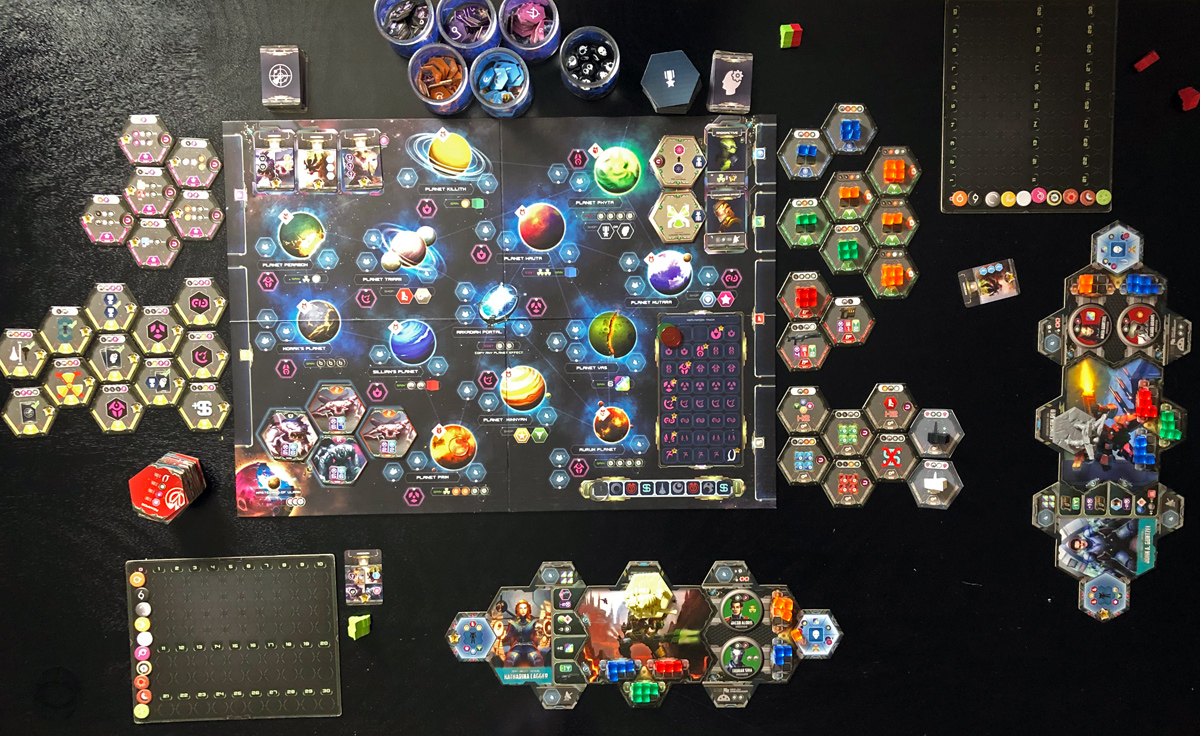
Setup only has a few minor additions to the base setup.

The additional pilot and mech tiles as well as the armor battery upgrade tiles are put into place along with their base game counterparts. The new combat dice are placed where they are within reach of all players.
The two major differences in setup are additions to each player’s setup. After the mech and pilot drafting is complete, either by draft or randomly, each player also picks one of the new combat panels. The combat panel nests on the right side of the mech just as the pilot does on the left. Appropriate armor and battery cubes are handed to each player based on their combat panel and placed on the panel. Then players receive the two ambassador tiles that match their player color. The ambassadors are also placed onto the new combat panel.
Gameplay – Expansion

While the new pilot and mech expand the combination possibilities and increase replayability and tactics, they don’t change any rules. The combat panel does have one new docking point that allows a player to pay three credits to repair two hull damage. The expansion though does make two fairly significant changes to the actual game play in the form of the Ambassadors and an almost entirely new combat system (built on top of the old system).
Ambassadors
Once each turn, at any time during their action phase a player can either deploy or activate one ambassador. This optional action gives players one of four choices to get a little boost. Activating an ambassador means paying the cost at the top of the ambassador tile to receive the bonus on the center of the tile. Once activated, the ambassador is flipped over and stays that way until the maintenance phase. Deploying costs 2 credits and allows a player to place the ambassador on any planet that they already have a ship docked. The player then receives the planet bonus whenever any other player docks on that planet. My strategy with this was to deploy my ambassador to planets that frequently got full and I couldn’t dock at so I could still get those resources. Unfortunately, the other players opted to starve themselves of those resources to keep me from getting my bonus. The ambassadors didn’t seem to significantly shift the outcome of the game, but it was definitely nice to have a way to get a quick resource or repair via activation.
Combat

The changes to combat are definitely the main driver of the expansion and make combat very different than in the base game. In the base game you always know exactly whether or not you can defeat a mutant; however, the new combat mechanics make it possible to not only lose against a mutant you could normally have defeated without question but also to potentially defeat a mutant you’d not be able to otherwise.
So, how does combat work in the expansion? Players must still have at least one armor to enter combat, but the amount of attack points are no longer a barrier to begin combat. Just as in the base game, when combat starts, the player takes damage as normal from the mutant. The player must then still pay the ammo and energy cost for their weapon as normal. Instead of the weapon’s attack number (and any bonuses) directly damaging a mutant, that is how many combat dice the player gets to roll. Each die has 3 types of faces – skull, one hit, and double hit.
A one hit die counts as one damage but a two hit die counts as two damage AND a critical hit. Every time a critical hit is rolled, the player can roll another die. This is where the chance of dice rolling can really work in your favor if you want to try attacking powerful mutants, as you can potentially do a LOT of damage with even the puniest of weapons. However, it can also backfire even on easier mutants.

The skull die counts as a miss, but all is not lost. Once per combat, the player can dock a miss onto the combat panel. The player then gets to choose one of the 6 rewards for the docked miss that they will receive at the end of the combat. This provides an opportunity to get even more bounty from a mutant kill, or even limp away with a small reward from a failed combat. The available bonuses are repairing any one type of cube, exchanging one favor resource for any other resource type, gaining one credit, gaining one reputation, removing one radiation, or converting one type of mutant DNA to another.
The final new piece to the combat is where the new Battery upgrade tiles and cubes come in to play. Once per combat, the player can spend one battery to re-roll any dice they want. This is where the press-your-luck comes in and can make or break your combat. If you roll all misses, you can easily decide to pay a battery and re-roll all of them. But what if you get two misses out of four? Do you keep a miss to dock for a bonus reward because you’re confident you can still defeat the mutant by just re-rolling one of them? What if you need to do 5 damage but roll 4 single hits and a miss? Do you re-roll just the miss or do you re-roll some of your hits as well, trying to get a critical?
If the player rolls enough damage to defeat the mutant, the mutant is collected and handled as normal.
Game End – Expansion
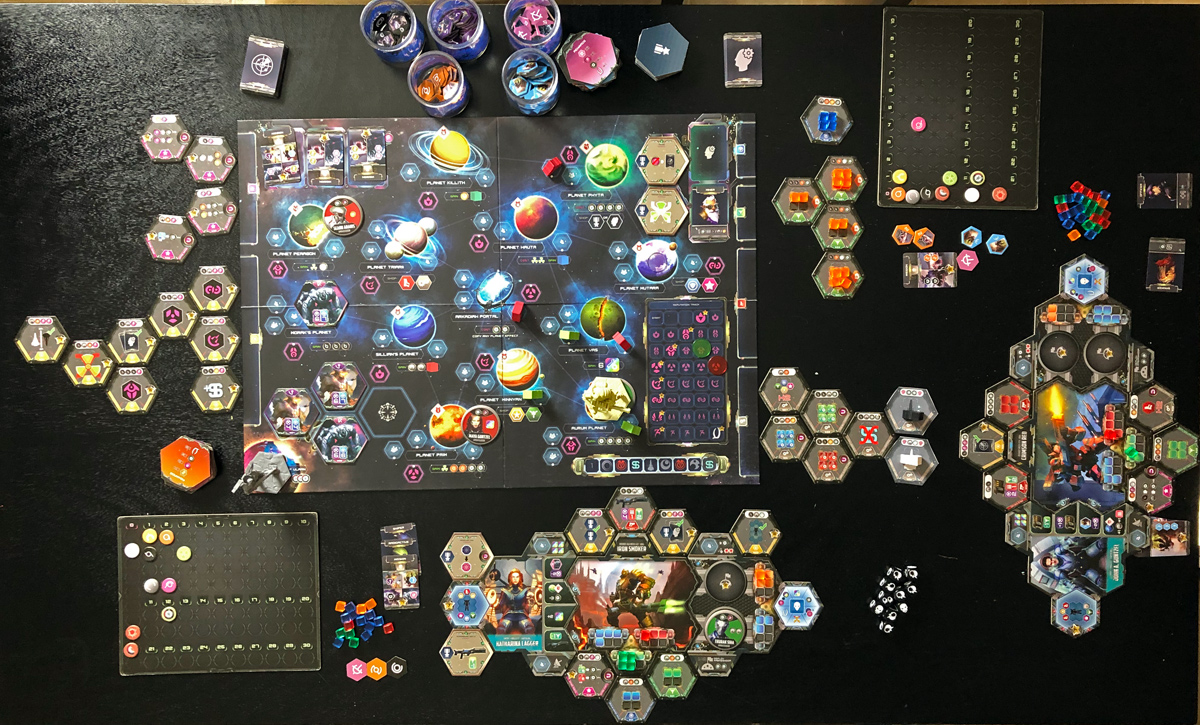
The only change to the end of the game and scoring is that 2 VP are awarded for each ambassador that has been deployed. The final score from our two-player game with the expansion was 43 to 50.
Why You Should Play Galaxy Hunters

First of all, Giant Mech Minis! Seriously, if you like mechs and painting minis, backing Galaxy Hunters is probably worth it just for these alone!
While there are definitely a lot of moving parts and things going on in Galaxy Hunters (and moreso with the added expansion), we can assure you that the game is not even remotely as complicated or overwhelming as it might first seem just looking at all of the components. Once the game is set up and you get a feel for the turns, the game itself moves pretty quickly. Because of both the ways that each player’s choices result in dwindling options for other players’ actions as a turn progresses and the plethora of different resources, there is actually a limited amount of trying to plan too far ahead that can be done and limited options for each player in a given turn or action anyway.
The flip side of that of course is that there are so many paths, choices, options, and ways to earn Victory Points, that the game has many ways to play and play styles it can appeal to. Add to that the pilot/mech/upgrade combinations and every game is pretty much guaranteed to be completely different than the last.
And all of the above is even more true with the addition of the New Ways to Hunt expansion and with the Kickstarter exclusives if you back the game now versus buying it at retail later. The addition of both more chance and press-your-luck mechanics with the expansion is also a great way to vary the way the game is played and depending on your gaming style, appeal more or less to different kinds of players. While I personally preferred the base combat (I like planning and succeeding or failing completely by my own merits), my wife preferred the expansion combat.
This is definitely a game we’ll be playing more when it releases, and one our entire family is very excited about. And with so much replayability, we’ll likely be playing it for a very long time.
For more information or to make a pledge, visit the Galaxy Hunters Kickstarter page!
Click here to see all our tabletop game reviews.
![]() To subscribe to GeekDad’s tabletop gaming coverage, please copy this link and add it to your RSS reader.
To subscribe to GeekDad’s tabletop gaming coverage, please copy this link and add it to your RSS reader.
Disclosure: GeekDad received a copy of this game for review purposes.

